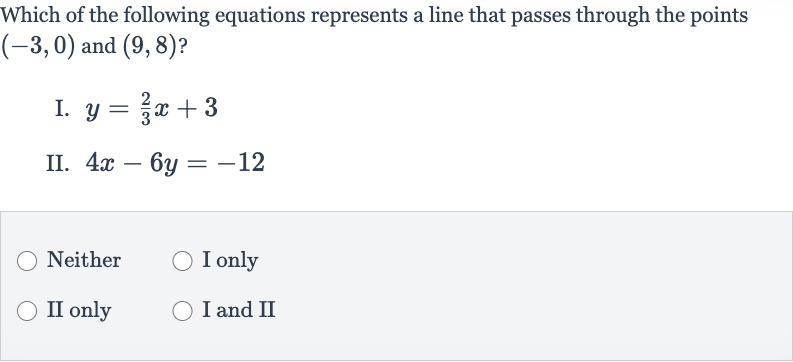Full solution
Q. Which of the following equations represents a line that passes through the points and ?I. II. NeitherI onlyII onlyI and II
- Question Prompt: Question prompt: Which of the following equations represents a line that passes through the points and ?
- Calculate Slope: First, let's find the slope of the line that passes through the points and using the slope formula .
- Check Equation I: Using the points and , we calculate the slope as follows:
- Check Equation I: Now, let's check equation I, , to see if it passes through both points. We will substitute the -values of the points into the equation and see if we get the corresponding -values.
- Check Equation II: For point , substituting into equation I gives us . This does not equal the -value of the point, which is . Therefore, equation I does not pass through the point .
- Rewrite Equation II: For point , substituting into equation I gives us . This does not equal the -value of the point, which is . Therefore, equation I does not pass through the point .
- Check Equation II: Now, let's check equation II, . We can rewrite this equation in slope-intercept form () to make it easier to compare with the slope we found earlier.
- Check Equation II: To rewrite equation II in slope-intercept form, we solve for :
- Check Equation II: To rewrite equation II in slope-intercept form, we solve for :
.Now, let's check if equation II in the form passes through both points. We will substitute the -values of the points into the equation and see if we get the corresponding -values. - Check Equation II: To rewrite equation II in slope-intercept form, we solve for :
.Now, let's check if equation II in the form passes through both points. We will substitute the -values of the points into the equation and see if we get the corresponding -values.For point , substituting into equation II gives us . This equals the -value of the point, which is . Therefore, equation II passes through the point . - Check Equation II: To rewrite equation II in slope-intercept form, we solve for :
.Now, let's check if equation II in the form passes through both points. We will substitute the -values of the points into the equation and see if we get the corresponding -values.For point , substituting into equation II gives us . This equals the -value of the point, which is . Therefore, equation II passes through the point .For point , substituting into equation II gives us . This equals the -value of the point, which is . Therefore, equation II passes through the point .
More problems from Write a quadratic function from its x-intercepts and another point
QuestionGet tutor help
QuestionGet tutor help
QuestionGet tutor help
QuestionGet tutor help
QuestionGet tutor help
QuestionGet tutor help
QuestionGet tutor help
QuestionGet tutor help

